
Wiesbaden is a city in central western Germany and the capital of the state of Hesse. As of June 2020, it had 290,955 inhabitants, plus approximately 19,000 United States citizens. The Wiesbaden urban area is home to approximately 560,000 people. Wiesbaden is the second-largest city in Hesse after Frankfurt am Main.
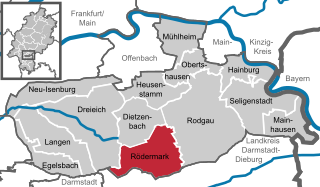
Rödermark is a town in the Offenbach district in the Regierungsbezirk of Darmstadt in Hesse, Germany, southeast of Frankfurt am Main and northeast of Darmstadt.

Bischofsheim is a municipality in Groß-Gerau district in Hesse, Germany with a population of more than 13,000.

Erbenheim is a borough of Wiesbaden, capital of the federal state of Hesse, Germany. It was incorporated into Wiesbaden on April 10, 1928. The population is around 10,000.
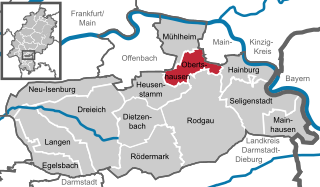
Obertshausen is a town in the Offenbach district in the Regierungsbezirk of Darmstadt in the state of Hesse, Germany. It has around 24,000 inhabitants.

Groß-Gerau is the district seat of the Groß-Gerau district, lying in the southern Frankfurt Rhein-Main Region in Hesse, Germany, and serving as a hub for the surrounding area. In 1994, the town hosted the 34th Hessentag state festival.

The Duchy of Nassau was an independent state between 1806 and 1866, located in what is now the German states of Rhineland-Palatinate and Hesse. It was a member of the Confederation of the Rhine and later of the German Confederation. Its ruling dynasty, now extinct, was the House of Nassau. The duchy was named for its historical core city, Nassau, although Wiesbaden rather than Nassau was its capital. In 1865, the Duchy of Nassau had 465,636 inhabitants. After being occupied and annexed into the Kingdom of Prussia in 1866 following the Austro-Prussian War, it was incorporated into the Province of Hesse-Nassau. The area today is a geographical and historical region, Nassau, and Nassau is also the name of the Nassau Nature Park within the borders of the former duchy.

Riedstadt, with its municipal area of 73.76 km² is Groß-Gerau district's biggest town by land area. It lies in Hesse, Germany, about 12 km southwest of Darmstadt.

The double city of Ginsheim-Gustavsburg in the northwest of Groß-Gerau district in Hesse has about 16,000 inhabitants.

Bürstadt is a town in the Bergstraße district in southern Hesse, Germany, 7 km east of Worms, and 17 km north of Mannheim. In 1981, the town hosted the 21st Hessentag state festival.
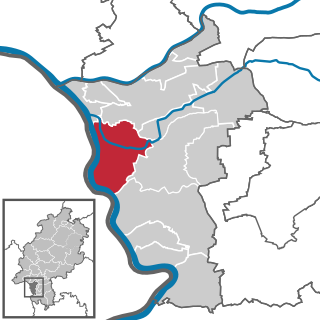
Trebur is a community in Groß-Gerau district in Hessen, Germany. It is 13 km southeast of Mainz, and 8 km south of Rüsselsheim.

Mainz-Kastel is a district of the city Wiesbaden, which is the capital of the German state Hesse in western Germany.

Frauenstein is the westernmost borough of the city of Wiesbaden, located in the Rhine Main Area near Frankfurt and capital of the federal state of Hesse, Germany. The borough has a population of approximately 2,400. The formerly independent village was incorporated into Wiesbaden in 1928.
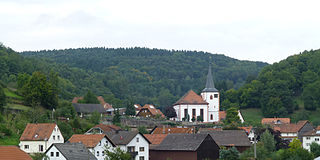
Flörsbachtal is a municipality in the Main-Kinzig district, in Hesse, Germany. It has a population close to 2,400. Flösbachtal contains both the oldest parish and the youngest settlement established in the Spessart hills. Located within the municipal territory is the Hermannskoppe, the highest elevation in the Hessian part of the Spessart and the Wiesbüttmoor, a rare hanging bog.
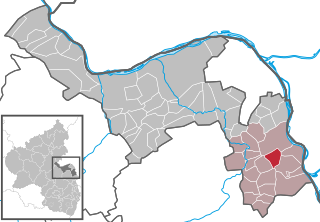
Dexheim is an Ortsgemeinde – a municipality belonging to a Verbandsgemeinde, a kind of collective municipality – in the Mainz-Bingen district in Rhineland-Palatinate, Germany.
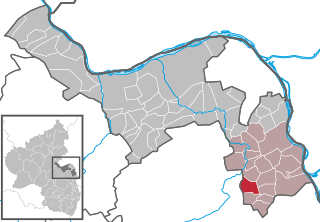
Dolgesheim is an Ortsgemeinde – a municipality belonging to a Verbandsgemeinde, a kind of collective municipality – in the Mainz-Bingen district in Rhineland-Palatinate, Germany.

Schwabenheim an der Selz is an Ortsgemeinde – a municipality belonging to a Verbandsgemeinde, a kind of collective municipality – in the Mainz-Bingen district in Rhineland-Palatinate, Germany.

Sonnenberg is a borough of Wiesbaden, the capital of the state of Hesse, Germany. Formerly an independent municipality, Sonnenberg was incorporated into Wiesbaden on 28 October 1926. The borough has approximately 8,000 residents.

Dotzheim is a western borough of Wiesbaden, capital of the state of Hesse, Germany. It is the second largest borough of the city by area and, with over 27,000 inhabitants the second-most populated of Wiesbaden's suburban boroughs. It was the largest village in the former Duchy of Nassau. The formerly independent village was incorporated into Wiesbaden in 1928.
The Ländchen was a region east of Wiesbaden, Germany that comprised ten villages: Breckenheim, Delkenheim, Diedenbergen, Igstadt, Langenhain, Massenheim, Medenbach, Nordenstadt, Wallau, and Wildsachsen, plus Domäne Mechtildshausen.
























